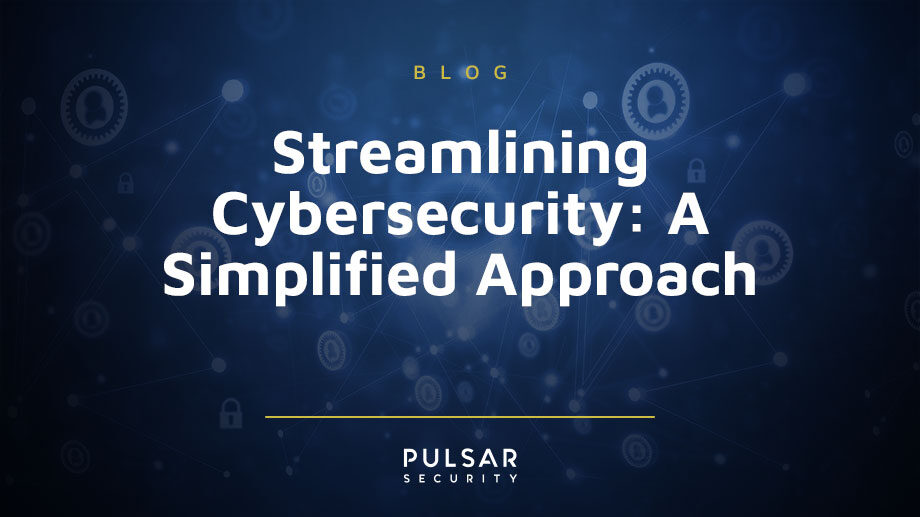Streamlining Cybersecurity: A Simplified Approach
The rapid advancement of technology has underscored the urgent need for robust cybersecurity measures today. Persistent cyber risks necessitate eliminating outdated security defenses and optimizing the enterprise security infrastructure.
In an environment teeming with cybersecurity risks that could tarnish a company’s reputation, the conventional wisdom of “prevention is better than cure” has often been the guiding principle for businesses. This mindset has prompted companies to accumulate a variety of solutions, adopting a “cream of the crop” strategy. Each new addition appears to be a wise and essential measure to tackle many issues.
Although this strategy might have initially appeared beneficial and comforting, the swift progression of digital innovation has led to a massive expansion of the potential targets for cyber-attacks. As a result, companies have grappled with complex security frameworks, overworked personnel, and escalating cybersecurity threats.
According to recent research on cybersecurity hazards, an alarming 50% of participants confessed that the digital battleground is “rapidly becoming unmanageable,” and they are perpetually engaged in damage control, struggling to manage their tasks.
In addition, as organizations implement a multitude of distinct cybersecurity solutions from various providers, they are also experiencing a rapid creation of data silos, skills deficiencies, and difficulties in achieving complete visibility of deployed cybersecurity tools and technologies. Adding to these obstacles is the paradox of swift technological progress, where advancements like generative AI introduce new dangers that companies must be prepared to confront.
These patterns highlight the need for a cybersecurity strategy shift — a wake-up call to simplify and consolidate the cybersecurity infrastructure. Put simply, companies must undertake a cybersecurity “spring cleaning”: a comprehensive evaluation and enhancement of their digital security controls and safeguards. However, the million-dollar question remains: where do they start this process?
What Makes Cybersecurity Integration Crucial?
Cybersecurity threats are swiftly progressing, with 66% of corporate leaders encountering a security breach and 57% of these individuals experiencing at least three such incidents. Moreover, as malicious actors progressively utilize artificial intelligence (AI) to orchestrate complex cyberattacks, corporations face a novel generation of threats to counter.
Simultaneously, IT landscapes are becoming increasingly sophisticated and limitless, with many firms now implementing strategies involving multiple clouds and various point products. This renders conventional risk management defenses inadequate, thereby exposing organizations to potential cyberattacks.
In this regard, cybersecurity consolidation fortifies risk management by safeguarding all potential targets using unified security platforms. Cybersecurity integration provides crucial security attributes and services, including DNS security, SD-WAN, and intrusion detection—all within a single platform, where they utilize collective intelligence to thwart attacks.
Moreover, consolidating cybersecurity tools and technologies bolsters an organization’s security posture by collaboratively disseminating intelligence to thwart threats instantaneously. Tools exchange user experiences, dashboards, and data points, equipping security teams with a comprehensive view of their cyber risk posture and a chance to centralize threat identification and mitigation.
Cybersecurity integration also minimizes the number of security services and tools implemented within a single framework. Modern organizations utilize an average of 76 security tools, each with its own acquisition, deployment, and maintenance requirements. However, with a consolidated cybersecurity framework, these tools and services are amalgamated into a handful of straightforward-to-manage platforms.
As a result, this allows security teams to optimize how they leverage pivotal technologies such as machine learning, artificial intelligence, and automation to expedite response times and minimize IT complexity.
Charting the Course Towards Cybersecurity Integration
Contrary to what one might assume, consolidating cybersecurity tools and technologies doesn’t merely suggest abandoning legacy security investments, particularly those that are integral to Security Operation Centers (SOC). A particular variety of cybersecurity solutions is unavoidable, as no single provider can cater to all security needs. In reality, many on this path are progressively reducing their reliance on less than ten vendors as a starting point. Besides, the concepts of “multi-layered defense” and “diversified defense” remain significant.
Instead, the objective of a consolidation strategy is to establish a foundational set of primary cybersecurity safeguards integrated into a single cohesive platform. Such a platform aims to enhance the risk posture and realize additional business advantages like cost and resource efficiency.
In pursuit of this goal, a path to consolidating adaptable cybersecurity processes that cause minimal disruption involves two crucial components: a gradual method for streamlining the security landscape and a platform capable of accommodating third-party integrations.
The initial step involves focusing on the security structure and its integration with the enterprise security framework. Specifically, take inventory of current security solutions and scrutinize your routine operations. Adopting the perspective of your SOC teams is the most efficient approach to conducting a comprehensive inventory. You might discover widespread problems stemming from an overabundance of tools.
A significant hurdle often encountered by SOC teams is the lack of a unified perspective of the attack landscape. In particular, analysts frequently toggle between numerous dashboards to comprehend the situation, often grappling with a flood of superfluous, unconnected alerts. This consumes valuable time and amplifies the risk of missing crucial vulnerabilities.
Thus, conducting this assessment will enable companies to understand their susceptible resources, operational hurdles, and the indispensability of the implemented solutions. Subsequently, this sets the stage for ranking and simplifying, mainly as numerous solutions demand specialized knowledge and may not be applicable in diverse settings.
Establishing a Consolidated Cybersecurity Framework
A consolidated cybersecurity framework can address issues arising from cybersecurity tool sprawl, optimize operations, and strengthen the overall cybersecurity posture. Such a framework provides unmatched visibility across the whole enterprise cybersecurity landscape.
Additionally, real-time visibility of the organization’s cybersecurity landscape allows companies to intercept threats early in the kill chain before any harm is inflicted. Ultimately, this enhances the probability of preventing attacks that can potentially cause prolonged downtime, destroy critical infrastructure, or cause reputational damage.
Automation allows SOC teams to promptly observe, analyze, and react to incidents more efficiently and accurately. Therefore, it’s not surprising that numerous companies undergoing consolidation prioritize Extended Detection and Response (XDR) technologies.
Furthermore, advanced, modern AI-enhanced XDR frameworks are engineered to revolutionize threat identification, detection, and reaction across networks, endpoints, OT/IT environments, and cloud. At the same time, they enabled security experts of diverse expertise levels to address the resource scarcity that most organizations are grappling with, considering the global cybersecurity workforce is confronting a significant workforce deficit of 3.4 million specialists.
Why is Cybersecurity Integration a Top Priority in 2024?
2024 marks a pivotal juncture in cybersecurity. Multi-cloud frameworks have become the norm rather than the exception, necessitating a more centralized oversight and visibility across the entire enterprise. Concurrently, the hybrid work model has emerged as the new norm in the workplace, accommodating employees who connect from various locations.
Components of a contemporary cybersecurity system, such as Security Information and Event Management (SIEM), Identity and Access Management (IAM), zero trust, threat intelligence, and others, must be seamlessly integrated to reap the advantages of optimizing the cybersecurity infrastructure and managing risk across the entire enterprise.
Also, malicious entities are receiving more substantial funding and becoming more advanced in leveraging automated attack methods to evade detection. With the aid of intelligent tools, attackers can craft more convincing deep fakes and phishing emails and employ automation to enhance the potency and scale of their attacks.
Moreover, consolidating cybersecurity measures can reduce expenses by eliminating the necessity for multiple independent security solutions and the corresponding administrative personnel. Furthermore, a centralized security infrastructure can ensure the consistent enforcement of security protocols across the organization, thereby enhancing adherence to industry norms and regulations.
To ensure that the unified system remains flexible, responsive, and capable of effectively tackling emerging security threats, the process of cybersecurity consolidation should be undertaken with meticulous planning and regard for the specific goals and needs of the organization.
Consolidate your Cybersecurity Tools and Services with Pulsar Security
Many organizations find it challenging to achieve cybersecurity consolidation. However, this process can be significantly simplified with the help of cybersecurity firms like Pulsar Security. With its team of experienced professionals and proprietary tools, Pulsar Security provides a comprehensive package of services designed to bring maximum security benefits at minimal cost.
Cybersecurity firms provide expert guidance and support throughout the consolidation process. They help organizations identify their unique security needs and challenges and develop a tailored consolidation strategy that aligns with their specific goals and requirements. This ensures that the consolidation process is efficient and effective in enhancing the organization’s overall security posture.
Also, cybersecurity firms offer a range of specialized tools and solutions that can simplify the consolidation process. For instance, they provide unified security platforms integrating various security functions into a single interface. This reduces the complexity of managing multiple standalone solutions and improves visibility and control over the organization’s security landscape.
Moreover, cybersecurity firms can help organizations optimize their use of advanced technologies such as automation, machine learning, and artificial intelligence. These technologies can significantly improve the organization’s ability to detect and respond to threats, thereby reducing the risk of security breaches.
In conclusion, the expertise and solutions provided by cybersecurity firms like Pulsar Security are invaluable in helping organizations achieve cybersecurity consolidation. Partnering with Pulsar Security helps your organization simplify the consolidation process and significantly enhance its cybersecurity defenses, ultimately leading to improved security posture, reduced complexity, and significant cost and resource efficiencies.

Peyton Somerville
Peyton is a Security Engineer at Pulsar Security. He is the technical contact for our customers - managing all Cyber Shield Vulnerability and Dark Web Assessments, and is on the Red Team. He has software development experience with Python, JavaScript, C, C++. He has earned his Offensive Security Certified Professional (OSCP), Network+ and Security+ certifications. Peyton first started with Pulsar as a intern while attending the University of Massachusetts - Lowell as a Computer Science major. He now leads the Pulsar Explore Internship Program ensuring all interns engage in hands-on learning, interactive mentorship, and learn about cyber career opportunities. Fun Fact: Peyton loves to snowboard, and even knows how to juggle.




